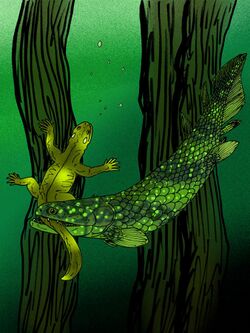Biology:Barameda
| Barameda | |
|---|---|

| |
| Barameda decipiens | |
| Scientific classification | |
| Kingdom: | |
| Phylum: | |
| Class: | |
| Order: | †Rhizodontida
|
| Family: | †Rhizodontidae
|
| Genus: | †Barameda
|
| Species | |
| |
Barameda (Indigenous Australian language: "fish trap"[1]) is a genus of rhizodont lobe-finned fishes which lived during the Tournaisian stage near the start of the Carboniferous period in Australia ; fossils of the genus have been reported from the Snowy Plains Formation.[2] The largest member of this genus, Barameda decipiens, reached an estimated length of around 3–4 metres (9.8–13.1 ft),[3] while smallest species, B. mitchelli is estimated to have had a length of about 35 centimetres (14 in).[4]
Description
The Barameda had an extremely elongated and thick body typical of Carboniferous rhizodonts. It was covered with moderately thin, cycloidal scales,[1] with thick bony plates covering its head and operculum (gill flaps), a tightly fused Skull roof, and extremely prominent, sharp fangs, devoid of serrations or cutting edges. Its scales preserved a lateral line.[2] Originally it was estimated to have a typical narrow pectoral fin, however a later study shows that it had a wider pectoral fin like other Carboniferous rhizodonts.[5]
Paleoecology
Along with other rhizodonts, Barameda seems likely to have been a benthic ambush predator, and its pectoral fins support that interpretation.[5]
References
- ↑ 1.0 1.1 Long, John A. (1989-03-30). "A new rhizodontiform fish from the Early Carboniferous of Victoria, Australia, with remarks on the phylogenetic position of the group". Journal of Vertebrate Paleontology 9 (1): 1–17. doi:10.1080/02724634.1989.10011735. ISSN 0272-4634. Bibcode: 1989JVPal...9....1L. https://doi.org/10.1080/02724634.1989.10011735.
- ↑ 2.0 2.1 Holland, Timothy; Warren, Anne; Johanson, Zerina; Long, John; Parker, Katherine; Garvey, Jillian (2007-06-12). [295:ANSOBR2.0.CO;2 "A new species of Barameda (Rhizodontida) and heterochrony in the rhizodontid pectoral fin"]. Journal of Vertebrate Paleontology 27 (2): 295–315. doi:10.1671/0272-4634(2007)27[295:ANSOBR2.0.CO;2]. ISSN 0272-4634. https://doi.org/10.1671/0272-4634(2007)27[295:ANSOBR]2.0.CO;2.
- ↑ Holland, Timothy (2010-12-14). "Upper Devonian osteichthyan remains from the Genoa River, Victoria, Australia" (in English). Memoirs of Museum Victoria 67: 35–44. doi:10.24199/j.mmv.2010.67.04. https://museumsvictoria.com.au/collections-research/journals/memoirs-of-museum-victoria/volume-67-2010/pages-35-44/.
- ↑ Jeffery, Jonathan E. (2012-09-01). "Cranial morphology of the Carboniferous rhizodontid Screbinodus ornatus (Osteichthyes: Sarcopterygii)". Journal of Systematic Palaeontology 10 (3): 475–519. doi:10.1080/14772019.2011.595961. ISSN 1477-2019. https://doi.org/10.1080/14772019.2011.595961.
- ↑ 5.0 5.1 Garvey, Jillian M.; Johanson, Zerina; Warren, Anne (2005-03-11). [0008:ROTPFA2.0.CO;2 "Redescription of the pectoral fin and vertebral column of the rhizodontid fish Barameda decipiens from the lower carboniferous of Australia"]. Journal of Vertebrate Paleontology 25 (1): 8–18. doi:10.1671/0272-4634(2005)025[0008:ROTPFA2.0.CO;2]. ISSN 0272-4634. https://doi.org/10.1671/0272-4634(2005)025[0008:ROTPFA]2.0.CO;2.
Wikidata ☰ Q4858312 entry
 |

